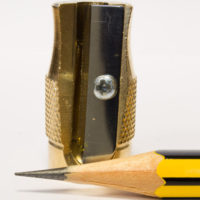Here in the UK there are several TV shows about buying holiday homes abroad or emigrating. One of those shows is “Wanted Down Under”. The format is usually the same and involves showing how much more people would earn down under and showing what to expect in terms of costs, facilities etc. I’ve never seen a whole episode, but over the years I’ve seen different bits from several episodes and (suspenseful music) they have never talked about the stationery situation down under!
Time to remedy this. Let’s look at the Castell 9000 down under.
Please enlarge by clicking, so that the differences are more obvious.
For the last three to four years Faber-Castell Australia [1]Their boss is our other favourite Count, Count Andreas Wilhelm Eberhard von Faber-Castell, who has been mentioned previously. has been buying the Castell 9000 pencils from their sister company in Indonesia [2]Made in Bekasi in one of several Faber-Castell plants in Indonesia. Here’s a photo of the impressive entrance.. They said that prior to this they bought them from Germany, but if Faber-Castell Indonesia is out of stock Faber-Castell Australia will request replenishment from Faber-Castell Germany.
In reality this situation seems to be a bit more complicated than that. You might remember Kevin from New South Wales because of his guest review of the Dahle 133 sharpener. Kevin reports that for the last eight to ten years he usually only came across Indonesian Castell 9000 pencils, the exception being some mixed grade tins, which are from Germany.
Sarab from Western Australia also struggles to find the German Castell 9000, which he prefers, and reports that its not easy finding a stationery shop in Europe that will ship small orders internationally. In his experience the differences in grade of the Indonesian Castell 9000 are very subtle or non-existent. In the past he managed to get Bavarian made Castell 9000 pencils in some branches of Jacksons Drawing Supplies, but now they also only stock Indonesian made Castell 9000 pencils.
There seem to be so many unused numbers after 9000. I can see that Castell 9000 is an established brand, but I wonder whether life wouldn’t be easier if the Indonesian pencil had another model number – what about 9001? It’s easy to distinguish the different 9000s anyway. In terms of colour and feel the paint of the Indonesian 9000, which doesn’t seem to be water-based, seems to be more similar to the paint used for the Mitsubishi 9800 and less similar to the one used for the Castell 9000 from Stein. The bar code, lead hardness font and print on only two sides of the hexagonal pencil also give the game away anyway…
Nearby, on Schwanberg, you can even find pencil cedars. The first seeds to plant these trees in Bavaria were imported by Lothar von Faber (Faber, 1873, p.44) [3]Faber, 1873. Die Bleistift-Fabrik von A. W. Faber zu Stein bei Nürnberg. Nürnberg : Sebald’sche Buchdruckerei.
I would like to thank Sarab, who brought this issue to my attention, Faber-Castell Australia for further information, Kevin for further information and for the Indonesian Castell 9000 he sent me in October 2011 and Sean for telling me about the book referenced in the third footnote.
More Castell 9000 related posts can be found at Contrapuntalism, Pencil Talk and Bleistift.
References
| ↑1 | Their boss is our other favourite Count, Count Andreas Wilhelm Eberhard von Faber-Castell, who has been mentioned previously. |
|---|---|
| ↑2 | Made in Bekasi in one of several Faber-Castell plants in Indonesia. Here’s a photo of the impressive entrance. |
| ↑3 | Faber, 1873. Die Bleistift-Fabrik von A. W. Faber zu Stein bei Nürnberg. Nürnberg : Sebald’sche Buchdruckerei |
